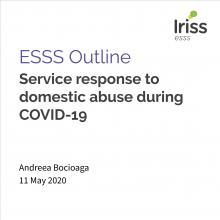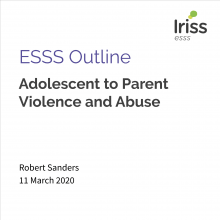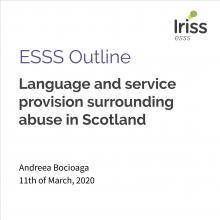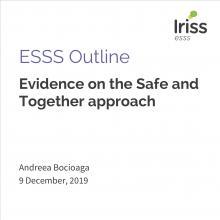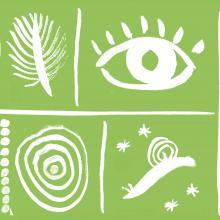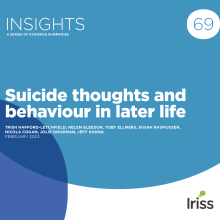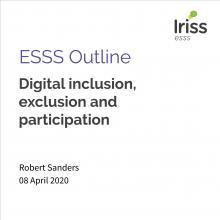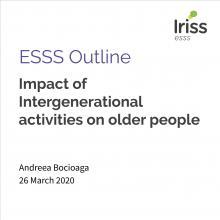Introduction
This evidence summary seeks to address the following question:
What are effective interventions for older women experiencing domestic violence and abuse?
About the evidence presented below
We drew on a wide range of evidence for this Outline. We looked at academic research in the fields of criminology, nursing, social work, public health, and law in relevant databases (e.g. ASSIA). We also used the Iriss National Social Services Search and Google Scholar, as well as the websites of key organisations (e.g. SCIE, Age UK). We limited the searches to literature published within the last 10 years, and most sources relate to the UK context.
The full scope of domestic violence and abuse among older women is unknown. This is due to significant underreporting and confusion around terminology. The United Nations (2013) state that "lack of agreed definitions" contributes to the invisibility of older women in domestic abuse evidence. The literature selected for this outline presents varying thresholds of "older": from 45 years old (Carthy and Taylor 2018) to over 60 (Bows 2018). Where possible, we have excluded literature on elder abuse, as these resources tend to ignore the gendered element of domestic abuse.
Accessing resources
We have provided links to the materials referenced in the summary. Some materials are paywalled, which means they are published in academic journals and are only available with a subscription. Some of these are available through the The Knowledge Network with an NHS Scotland OpenAthens username. The Knowledge Network offers accounts to everyone who helps provide health and social care in Scotland in conjunction with the NHS and Scottish Local Authorities, including many in the third and independent sectors. You can register here. Where resources are identified as 'available through document delivery', these have been provided to the original enquirer and may be requested through NHS Scotland's fetch item service (subject to eligibility).
Where possible we identify where evidence is published open access, which means the author has chosen to publish their work in a way that makes it freely available to the public. Some are identified as author repository copies, manuscripts, or other copies, which means the author has made a version of the otherwise paywalled publication available to the public. Other referenced sources are pdf and websites that are available publicly.
Background
Multiple disadvantages grounded in traditional gender roles, economic disparities and barriers to health and mental health services shape the ageing process of women, and make older women more vulnerable to violence and abuse than their male counterparts (Choi et al. 2017). Women's Aid (2017) state:
[D]omestic abuse is deeply rooted in the societal inequality between women and men and in enduring notions of masculinity and femininity.
COSLA and Scottish Women’s Aid (2016) describe domestic violence and abuse as:
[Pe]rsistent and controlling behaviour by a partner or ex-partner which causes physical, sexual and/or emotional harm. It is common but often concealed. In most cases, it is experienced by women and children and is perpetrated by men.
Police Scotland and the Crown Office and Procurator Fiscal Service (2017) define domestic abuse as:
[A]ny form of physical, verbal, sexual, psychological or financial abuse which might amount to criminal conduct and which takes place within the context of a relationship. The relationship will be between partners (married, cohabiting, civil partnership or otherwise) or ex-partners. The abuse can be committed in the home or elsewhere including online.
This definition also acknowledges that domestic abuse as a form of gender based violence is predominately perpetrated by men against women and also includes abuse of male victims by female perpetrators and includes abuse of lesbian, gay, bisexual, transgender and intersex (LGBTI) people within relationships (Police Scotland and the Crown Office and Procurator Fiscal Service 2017).
As with all forms of domestic abuse, abuse of older people is widely underreported and recorded (Welsh Government 2017). Data-collection methods for obtaining prevalence rates on neglect, abuse and violence against older women can be complex, expensive and time-consuming (United Nations 2013). Clear evidence of the scale of the issue is difficult to obtain as the Crime Survey for England and Wales 'intimate personal violence' self-completion section is only offered to adults up to 59 (Solace Women's Aid 2016). A recent report from Women's Aid (2017) found that women over 60 appear to be under-represented in their sample of service users, but this cannot be taken to mean that women in these age groups are not experiencing domestic abuse.
The exact prevalence rates of violence and abuse against older women are hard to estimate because of varied definitions of abuse as well as old age (United Nations 2013). Knight and Hester (2016) state that prevalence figures are variable but the likely lifetime prevalence for women over the age of 65 is between 20 and 30%. Safelives (2016) estimate that in 2015, approximately 120,000 individuals aged 65+ have experienced at least one form of abuse in England and Wales. Data from the Domestic Homicide Review (2016) for England and Wales show that an increasing number of people aged 60+ are victims of domestic homicide; 8% of the women killed by a partner or ex-partner in 2016 were aged 66 or over.
In more recent years the deficit in both research and resources for older adults has been acknowledged worldwide, however older women are still described as "invisible victims" of domestic abuse (Carthy and Holt 2016). Some studies also reveal that a number of organisations in the UK do not keep detailed statistics of referrals or client demographics, thus further exacerbating the invisibility of older people within support provision overall (McGarry et al. 2014).
The experience of domestic abuse amongst older people varies; for some they will have experienced abuse at the hands of their partner for many years, while for others, the abuse may be a characteristic of a new relationship started in later life (Welsh Government 2017). While many older women report a decline in the physical and sexual aspects of abuse as their male partners age, this reduction appears to correlate with an escalation of psychological abuse and non-violent controlling behaviours (Carthy and Holt 2016). For some older people, the abuse may have started as they've reached older age and/or become frail or cognitively impaired (Welsh Government 2017).
Impact
According to the Welsh Government (2017):
All forms of domestic abuse have a profound effect on those who experience it. It can result in short and long term consequences for the individual's mental health and wellbeing, an increased risk of physical injury, and in some cases, death. The consequences of abuse can lead to homelessness, isolation and long term social exclusion.
There is a strong association between being a victim of domestic abuse and experiencing increased rates of mental and physical health problems in older adults (Knight and Hester 2016). Older women who reported experiencing abuse perceived their quality of life as being lower than that of women who had reported not experiencing abuse (United Nations 2013). According to Carthy and Holt (2016) some of the specific issues associated with domestic abuse among older women include:
- Increased likelihood of depression, anxiety and risk of suicide
- Negative impact on cognitive functioning, such as memory lapses and difficulties with concentrating
- Chronic pain, including bone and joint problems, digestive problems and high blood pressure
- Substance misuse, such as heavy alcohol use, smoking and the use of prescription and non-prescription drugs
Older adults experience all the same psychological effects as younger adults as a result of domestic abuse, such as the wearing down of their confidence, the restriction of opportunities for success and personal growth, and at times severe social isolation (Knight and Hester 2016). Domestic abuse is likely to have a huge impact on someone's mental health, and controlling tactics may be compounded by wider societal types of oppression, including ageism (Women's Aid 2017). Other stated effects include tension, anger, hatred, and feelings of powerlessness (United Nations 2013). Knight and Hester (2016) also found that an increase of frailty and dependence on others for support can put older people at risk of specific types of abuse, and people who are unwell might:
- Be vulnerable and have less ability to defend themselves from physical attack and verbal assaults
- Be neglected and denied food and water if they are immobile
- Have continence needs which can be used as a vehicle for abuse
Their illness may also impact their view of themselves, their needs within relationships and their responses to mistreatment from others (Knight and Hester 2016). The impact of domestic abuse and sexual violence is often especially acute where the abusive partner is also the main carer; the carer has considerable power and control and the victim has total reliance on them (Welsh Government 2017)
Older people may also be affected by what may be perceived as 'low level' individual incidents that are part of a longstanding pattern of cumulative abusive behaviour (Solace Women's Aid 2016) and prolonged exposure to trauma is a feature of many older women's experience of domestic abuse (Centre for Research on Families and Relationships 2008). As a result of experiencing abuse for many years, many women develop coping mechanisms and accept domestic abuse as part of everyday life (Rogers 2016). They may also experience an increased feeling of shame because they have stayed with an abuser for years (Solace Women's Aid 2016).
Older women are more likely to be living with their abusers than younger women (Centre for Research on Families and Relationships 2008) and be spending more time with their abusers following retirement from work (Solace Women's Aid 2016). The United Nations (2013) found that women who were retired had a higher probability of abuse compared with those who were still working. Dependence, particularly financial, and isolation are common experiences for older women affected by domestic abuse. According to the Centre for Research on Families and Relationships (2008), women's dependence seems to be a product of limited economic assets, constricted access to income and housing, and progressively fewer avenues for obtaining financial independence as they age.
Barriers to seeking help
Age can present challenges for women accessing services (Women's Aid 2017). Barriers to seeking help by older women victims of abuse may be both internal, such as feelings of hopelessness and concern for the abuser, or external, for example, lack of services specifically designed for older women victims' needs (United Nations 2013).
Access to services and resources
The literature suggests that older women are less likely to access domestic abuse services and resources than younger women. Possible reasons for this include a belief that services are only for younger people or or people with young children (Welsh Government 2017) and limited awareness of the formal services and options available to them (Safelives 2016). Rogers (2016) also identifies the following barriers:
- A reluctance to share services, particularly housing, with younger women
- Feeling that they would not be believed if they spoke out about domestic abuse
- Stigma and embarrassment in contacting services or disclosing abuse to practitioners
According to a Safelives (2016) report, services often do not respond to older victims in an appropriate and targeted way, and older people are not represented in marketing materials for these services. There is a perception that supported housing is more suitable for younger women with children (Rogers 2016) and research shows that many women's refuges are not able to fulfil the practical needs of older women, especially those with disabilities (Solace Women's Aid 2016). This is supported by figures from Women's Aid (2017), with only one out of 276 refuge services listed on Routes to Support offering specialist services for women over 45.
The issues experienced by older women may be exacerbated in rural communities, where professional awareness and response to domestic abuse remains quite limited because the culture of self-sufficiency, patriarchal social structures, limited community service options, social and geographic isolation, and widespread economic hardships contribute to and conceal violence in relationships (Brossoie and Roberto 2015).
Attitudes and beliefs
The attitudes and beliefs of older women may be a barrier to seeking help. Some of these attitudes might include:
- A lack of faith in authorities (Carthy and Taylor 2018)
- Social expectations around marriage (Brossoie and Roberto 2015)
- Preconceptions that as a mature person they should be more able to cope living with abuse (Rogers 2016)
- A degree of acceptance surrounding domestic abuse (Solace Women's Aid 2016)
- A belief that home is a private domain, and it is not socially acceptable to discuss matters that occurred behind closed doors (Safelives 2016)
Many of these attitudes are described as being exacerbated for older BAME women, particularly those from a religious background who may face additional personal and familial pressures to stay with an abusive partner (Safelives 2016). In rural areas, there might be additional values and expectations preventing women from seeking help, such as the value of self-sufficiency and distrust of state intervention and outsiders offering help (Brossoie and Roberto 2015).
Financial concerns
Older women often have significant concerns surrounding their financial situation when seeking support for domestic abuse. Victims are more likely to be financially dependent on their abuser than younger people (Welsh Government 2017), and Solace Women's Aid (2016) identified the following issues through their research:
- Older women may have no formal education, no experience of work outside the home or independent economic resources
- Older women may have savings/capital/pensions which makes them ineligible for access to social housing, benefits, legal aid and community care grants
Carthy and Holt (2016) also state that older women may have fewer future opportunities for education or learning new skills, which can add to feelings of financial vulnerability.
Caregiving
Rogers (2016) found that the status and role of the victim and perpetrator in terms of caring, illness and dependency was a barrier for seeking help due to preconceived perceptions about how the other person would be unable to manage without the carer. Older women may feel guilty about leaving a now frail, albeit abusive, partner who may rely on them for care and support with everyday living (Knight and Hester 2016). In some instances, an older woman may be subjected to abuse by her partner as a result of the partner's age-related mental or physical illness (Yechezkel and Ayalon 2013).
The perceived vulnerability of the perpetrator may make it harder for professionals to identify domestic abuse (Safelives 2016). Lack of service provision may make it difficult to make alternate care arrangements for the perpetrator, even though people who have been victimised over long periods of time may struggle to provide care (Knight and Hester 2016).
Receiving care
Older people are statistically more likely to suffer from health problems, reduced mobility or other disabilities, which can exacerbate their vulnerability to harm (Safelives 2016). Perpetrators may deliberately emphasise and reinforce dependency as a way of asserting and maintaining control (Welsh Government 2017). Many older women have special care needs or disabilities that are not catered for in current service provision (Carthy and Holt 2016) and the lack of specialised services for victims with disability forces them to stay in abusive relationships (Safelives 2016).
Women with care and support needs who are coerced and controlled by carers may have more difficulties in recognising their experience as abuse (Welsh Government 2017). Problems with physical health and subsequent isolation can present barriers to victims being able to access community services, as they may be unable to easily leave their home (Safelives 2016).
According to the Welsh Government (2017) disabled women are twice as likely to experience violence and sexual abuse as non-disabled women. The literature also shows increased odds of domestic abuse among people with dementia compared to those without dementia (McCausland et al. 2016). The effect of dementia can render older people more susceptible to exploitation by others and can severely impair their ability to seek help, advocate for themselves or remove themselves from potentially abusive situations (Welsh Government 2017).
Challenges for women's organisations
According to the Centre for Research on Families and Relationships (2008), systemic barriers such as inappropriate housing and refuge options, ill-informed gatekeepers to services (particularly physicians and others in health services) and inadequately resourced aged and domestic abuse services all add to the enormous challenges faced by older women seeking safety. Policymakers are increasingly focusing on short-term, cost-effective and gender-neutral solutions, which fail to address the underlying causes of domestic abuse (Ishkanian 2014). Ishkanian (2014) states:
[I]n the context of domestic violence, effective services aren't just about providing a bed for the night, but also supporting the recovery and empowerment of victims, investing in education and prevention programmes as well as working with perpetrators of violence.
Women's Aid (2017) found a trend towards commissioning of fewer, larger services who do not specialise in domestic abuse provision. A number of leading domestic abuse charities and experts have expressed concern that this shift toward generic service provision will lead to "the potential loss of specialist knowledge, skills and experience" in delivering services (Ishkanian 2014). Generic service provision may also be limited by what McGarry et al. (2014) describe as "age blindness". The relevance of age may seem unclear to larger organisations, where the focus in some areas is on integration and ageless provisions (Knight and Hester 2016).
There is currently a gap in the research looking at how changes in the policy context impact older women victims of domestic abuse. The majority of the literature included in this Outline emphasises the need for specialised services for older women to fit their needs and experiences, presenting a challenge for women's organisations where, according to Sanders-McDonagh et al. (2016), specialised services are in decline. Women's Aid (2017) report that funding cuts impact the ability of services to deliver a full range of support groups, evening support sessions or capacity to liaise with external agencies. In an evaluation of the Silver Project, a domestic abuse services for women over 55, Solace Women's Aid (2016) state:
Sustaining the project in the long term is a challenge in the current financial climate. The changes to welfare legislation and legal aid cuts have resulted in a greater demand on the service as women find it increasingly difficult to access benefits and legal advice.
Evidence
Identifying domestic abuse
The literature suggests that there is a lack of knowledge of the impact of domestic abuse on older women amongst service providers and professionals (Carthy and Taylor 2018). In over 65's, for example, identification of couples experiencing domestic abuse is poor and there are very limited options for onwards referral after identification (Knight and Hester 2016). Some studies indicate that there is confusion among agencies as to what constitutes elder abuse versus domestic abuse in later life (McGarry et al. 2014). Domestic abuse may be confused with carer stress (Carthy and Holt 2016) or with medical symptoms associated with old age (Yechezkel and Ayalon 2013). Older women may also be more reluctant to talk about problems at home due to experiential, cultural, and social factors, and this combined with ageing and subsequent care needs leaves them vulnerable to having domestic abuse overlooked (Carthy and Holt 2016).
The limited training available on the specific issues faced by older victims of domestic abuse may mean that practitioners lack the skills and knowledge to respond to it confidently (Safelives 2016). Professionals working with older people may miss signs of abuse due to their own assumptions and perceptions of domestic abuse and ageism (Brossoie and Roberto 2015; Yechezkel and Ayalon 2013). A failure to recognise and effectively respond to domestic abuse in an older person may lead to inappropriate referrals and potentially unsafe outcomes (Welsh Government 2017). McGarry et al. (2014) state that heightening awareness, for both the public and for professionals working in a wide range of services, would enable early indicators to be actioned upon.
Bows, H (2017) Practitioner views on the impacts, challenges, and barriers in supporting older victims of sexual violence. Violence Against Women, 24(9), pp.1070-1090 (open access)
This study reports results of interviews with 23 practitioners who were supporting victims of sexual violence aged 60 and over. The findings indicate that the physical and emotional effects of sexual violence on victims led to limited lifestyles, disengagement from social networks, and reliance on pathogenic coping strategies. Provision of effective support was complicated by challenges associated with ageing bodies, including health issues and dementia, as well as the social stigma attached to both sexual victimhood and older age. The author identifies that there is a lack of training and guidance available to practitioners, possibly due to the low numbers of older people who access support services for rape and/or wider attitudes around older people and sexual violence. Interagency collaboration is key to sharing best practice knowledge as well as raising awareness and encouraging cross-referrals between organisations.
Brossoie, N and Roberto, KA (2015). Community professionals' response to intimate partner violence against rural older women, Journal of Elder Abuse & Neglect, 27(0), 470–488 (author manuscript)
This paper examines community professionals' awareness and perceptions of and experience with domestic abuse in later life in a rural setting. The authors conducted 12 focus groups with 72 local community professionals who were likely to encounter older women with experience of domestic abuse. They found that participants likely encountered victims of domestic abuse, although most appeared unaware of the abuse at the time. The findings also indicate that perceptions of domestic abuse later in life were shaped by the social norms and cultural values in their communities as well as the professional lens of participants. The authors state that each profession included in the study could benefit from increased education and awareness about domestic abuse and older women, screening and intervention tools, community services and resources, and interagency collaboration.
Carthy, NL and Taylor, R (2018) Practitioner perspectives of domestic abuse and women over 45, European Journal of Criminology, 15(4), pp.503–519 (paywalled)
In this study, 18 practitioners from north-east of England were interviewed to explore their experiences of working with women 45 and older who were victims of domestic abuse. Two core themes emerged: (1) practitioners saw an 'uncertain future' as a barrier to women seeking support and (2) practitioners expressed a lack of knowledge of domestic abuse and service provision. The gaps in knowledge and service provision identified in the study include:
- Lack of awareness among the public and professionals of the existence of support services
- Lack of services available in the community for older women in general
- Lack of professional knowledge of how to respond to disclosure of domestic abuse
- Lack of training to recognise the signs of domestic abuse
The participants suggested the best way to respond to these deficits was to raise awareness of age variations in domestic abuse through education, advertisements and media campaigns. The authors also illustrate the value of multi-agency working to respond to the complexity of issues that arise in domestic abuse cases, and the importance of workers understanding the needs of older women and how those needs may differ from those of younger women.
Knight, L and Hester, M (2016) Domestic violence and mental health in older adults, International Review of Psychiatry, 28(5), pp.464–474 (paywalled and author manuscript)
This literature review examines the link between mental health and domestic abuse in adults over the age of 65. The authors note that while there is limited evidence in this area, the literature suggests an association between being a victim of domestic abuse and experiencing increased rates of mental and physical health problems in older adults. They also state that the identification of couples experiencing domestic abuse is poor in over 65's and there are very limited options for onward referral. Identification of abuse had occurred primarily as a result of physical abuse being reported, and there was no evidence of patients or carers being asked about domestic abuse directly as part of a normal assessment. In addition to this, there is also an issue of older people not recognising themselves as victims of domestic abuse, instead they tended to minimise the difficulties and conflict within their relationships.
Yechezkel, R and Ayalon, L (2013) Social workers' attitudes towards intimate partner abuse in younger vs. older women, Journal of Family Violence, 28(4), pp.381–391 (paywalled and author manuscript)
This research examined responses of 212 social workers, who were randomly assigned one of four case vignettes describing intimate partner abuse. Social workers tended to define intimate partner abuse against an elderly woman as non-abusive, in contrast to intimate partner abuse against a young woman. The findings show that, in general, social workers preferred to initiate therapeutic intervention rather than legal intervention, particularly in cases of emotional abuse.
Interventions and management
Many of the problems facing older victims are common to all of those experiencing domestic abuse, however, older victims' experiences are often exacerbated by social, cultural and physical factors that require a tailored response (Safelives 2016). Data from Women's Aid (2017) shows that only 3.5% of community-based service users and 1.7% of refuge residents were aged 56 and over, raising questions about how services can reach out to older victims and adapt their services to be suitable and welcoming.
There is little evidence that any countries are delivering a cohesive response to domestic abuse in later life (Knight and Hester 2016). Many papers acknowledge the complexities of the problem and call for coordinated and collaborative interagency partnerships to address the unique intersection of needs of older women victims (Brossoie and Roberto 2015; Bows 2017) across health services, criminal justice services, social services and the voluntary sector (McCausland et al. 2016).
The differences between younger and older women's experiences are rarely taken into consideration in current service provision and leaves many older women unsupported, for example, in refuge accommodations that lack amenities for those with physical or cognitive disabilities or ageing and older life health issues (Carthy and Taylor 2018). In their study looking at the practitioner perspectives of domestic abuse and women over 45, Carthy and Taylor (2018) reflect on the EVA Women's Aid 45+ Project, a refuge set up specifically for older women thought to be the first of its kind in the UK. They report that:
- Older women tend to stay longer in the safe house and often need longer-term support (such as attending groups) after the end of higher-risk intervention
- The need for longer-term support can be attributed to older women's issues being more embedded and thus requiring more time to allow slower changes to occur
- Older service users prefer an older support worker
- Older women reported a greater impact on their lives following successful intervention
While housing support is the most commonly proposed service in the literature, other services might include an "accessible listening service" and "ongoing help and empowerment" (Carthy and Taylor 2018). Mears (2015) emphasises the "vital importance" of support networks and support groups for older women, and of creating spaces where they can tell their stories in a supportive, respectful environment.
Centre for Research on Families and Relationships (2008) Older women and domestic violence in Scotland (pdf)
This research briefing from 2008 lists a number of policy implications relevant to service development for older women experiencing domestic abuse. These include:
- Acknowledge the specific needs of older women by shifting service focus from women with children and providing housing options better suited for women in need of both self-contained and shared living spaces
- Listen to older women's stories, involve older women in service design and re-design, and include older women in policy and decision making
- Increase screening of older women for domestic abuse by health professionals and improve training and support for GPs and A&E staff
- Introduce effective outreach strategies to improve access to services, including those that target adult children
- Improve housing and refuge options as well as aged and domestic abuse services
- Design new services for women who live with abusive men, as older women are more likely to live with their abusers
- Develop community-based, multi-agency groups that address violence against women through increasing mutual participation between domestic abuse professionals and elder services
- Encourage cooperation and collaboration through cross-training and integrated referral systems
Choi, M et al. (2017) International movement to promote human rights of older women with a focus on violence and abuse against older women, International Social Work, 60(1), pp.170–181 (open access)
Population ageing around the world has drawn increased attention to the issue of human rights of older people. Extended old age is a women's issue, considering women's longevity advantage over men. Gender inequalities across the life course often make women more vulnerable to violence, abuse and poverty in old age than men. The human rights framework provides a solid foundation to approach the issue of violence and abuse against older women. This article critically reviews the United Nations instruments, with a focus on the international movement to promote human rights of older women, and provides implications for global social work practice.
McGarry, J et al. (2014) An exploration of service responses to domestic abuse among older people: findings from one region of the UK, Journal of Adult Protection, 16(4), pp.202–212 (paywalled)
The overall aim of this study was to examine service responses to abuse among older people across a range of sectors. 18 individuals from a range of agencies (both statutory and voluntary) as well as three older women victims took part in postal questionnaires and semi-structured telephone interviews. The findings highlighted three main themes:
- Lack of conceptual clarity between domestic abuse and elder abuse
- Complexity of family dynamics and abusive relationships
- Deficit in dedicated service provision for older victims
The respondents in this study also felt that older people were excluded through the ways in which domestic abuse services were publicised or presented in the public domain.
Roberto, KA and McCann, BR (2018) Violence and abuse in rural older women's lives: a life course perspective, Journal of Interpersonal Violence, (0555), pp.1–23 (paywalled)
Intimate partner violence in later life includes physical, psychological, sexual, and financial abuse. Although some researchers have investigated how women in long-term violent partnerships cope with abuse, little is known about the history, experiences, and needs of older women who leave abusive relationships. From a feminist, life course perspective, the authors interviewed 10 women who had left their abusive partners later in life. They used qualitative methods to analyze the data and found four major themes:
- The women used the past to account for abuse in their relationships later in life
- Recognizing abuse signaled to the women to fight back and exit the relationship
- Financial abuse and exploitation affected women's mental and physical health
- Rebuilding was especially challenging as the women faced their future alone with financial, physical, or mental health problems
The authors conclude that abuse presents lasting and unique challenges for older women.
Rogers, M (2016) Barriers to help-seeking: older women's experiences of domestic violence and abuse - briefing note (pdf)
The aim of this research was to gain knowledge relevant to housing, health and social care providers. Rogers identifies the following enablers for services for older women who have experienced domestic abuse:
- Overwhelming needs for more awareness raising within housing, health and social care sectors
- Better understanding of older women's needs and the impact of longevity and the influence of duty and commitment in abusive relationships
- Person-centred practice and approaches which centred the individual as the 'expert' were identified as being of value particularly for the older victims who did not wish to leave their home and relationship, but who wished to gain some emotional and social support
- Non-domestic abuse agencies (for example, housing, health, substance misuse, and community based social care) were seen as key in terms of facilitating the process to enabling older victims to engage with specialist domestic abuse support
- Need for age-appropriate support and housing provision as well as tailoring existing domestic abuse interventions to older women groups
Safelives (2016) Safe later lives: older people and domestic abuse (pdf)
This report proposes recommendations for both practitioners and policymakers based on a wide-range of evidence. Some of the suggestions include:
- Recognise that the need for consistent dialogue with older people about their experiences and encouragement to accept help is highly necessary.
- Embed domestic abuse education regarding older women within general domestic abuse training for a range of professionals, in order to increase confident responses, recognition and suitable action
- Ensure services are responsive to older victims in an appropriate and targeted way
- Produce advertising campaigns that are focused on older victims
- Avoid pressuring older women to leave their relationship when statistics show that they are less likely to do so than younger women; this can lead to a sense that victims are not being listened to
- Recognise the importance of victims having one point of contact to build a rapport with
- Increased coordination between domestic abuse services and adult safeguarding services
- Greater coordination between health services and domestic abuse services.
- Specific training for professionals on the incidences of abuse within a caring relationship, and/or where dementia or other mental/physical disabilities are present
- Embedded domestic abuse champions within adult services sector
Solace Women's Aid (2016) The Silver Project : domestic abuse service for women over 55 - evaluation report (pdf)
The Silver Project provided women with support, advice and information and transport assistance to access domestic violence awareness programmes, confidence building workshops, support groups, day centres, Age UK activities and peer befriending, in order to increase their understanding of domestic violence and better address their isolation. This project worked with over 120 older women affected by domestic and sexual violence between 2013 and 2016. The evaluation is based on monitoring data, feedback from service users and providers, and interviews. Some of the key observations made in this report include:
- Women who used the service repeatedly confirmed that their cases were often complex and needed special attention.
- Many of the women required longer periods of time to build relationships of trust before disclosing, engaging and acting on advice given
- Health concerns were paramount for this age group and impacted differently with each case depending on the nature and severity of the service user's ill health
- The risk of fatality is high in this age group as a result of domestic violence, therefore closer links are needed with police and social services to ensure early identification of risk and the need for a specialist intervention
According to the women who access Silver Project services, one of the benefits was an improvement in their safety through a range of options such as seeking alternative housing, obtaining a Non-Molestation order and collaborative work with the police to place security measures in the home and in courts. Their feedback also suggested an increased number of external agency practitioners to be trained to recognise the needs of older women, greater promotion of the issue, and continued funding to increase the number of women the service could support.
In addition to providing services for older women, the Silver project also developed training material for external services to raise awareness on issues pertaining to disclosure and the barriers faced by women over 55 experiencing domestic abuse. This is in line with feedback from service users, who felt that more support and consistency was needed from all services, including the police.
United Nations (2013) Neglect, abuse and violence against older women. Division for Social Policy and Development: Department of Economic and Social Affairs (pdf)
This report examines domestic abuse against older women using three different frameworks: older adult mistreatment; abuse of vulnerable adults; and intimate partner violence (IPV). Services gaps identified in this report include:
- A need practical information about how to leave abusive situations
- Where to find places of safety or available housing
- How to access pensions and other benefits
- How to manage personal financial issues
- How to obtain a divorce
In addition to this, service systems for older adults may not identify power and control dynamics that are inherent in intimate partner abuse of older women, and domestic violence services are not always well-suited to older women's needs. Services like support groups and community outreach were important to older women victims of abuse. A list of recommended interventions is included in the report, which covers:
- Interventions for older women caregivers of abusive men
- Services for older women with care needs
- Legal services for older women victims of abuse
- Support groups for older women victims of abuse
- Domestic violence shelters for older women victims of abuse
- Training and education on abuse in later life for professionals and students
- Interventions aimed at perpetrators
- National legislative approaches
Welsh Government (2017) Information and guidance on domestic abuse: safeguarding older people in Wales (pdf)
This document was designed to provide frontline professionals with guidance on how to recognise, respond and provide support to disclosures of abuse. It provides a clear summary of the complex issues surrounding the issue, as well as a number of case studies. It also highlights the need for organisations consider this issue at a strategic level and in partnership arrangements, and offers the following considerations:
- Older victims may need prolonged interventions due to their abuse being sustained over a longer period
- Professionals who deliver care to older people need to be trained to recognise abuse and to provide an effective intervention
- Care and dependency issues are often intertwined and effective responses require coordination between health, safeguarding and domestic abuse services
- Needs assessments, commissioning and service redesign consider the needs of older people
Women's Aid (2017) Survival and beyond: domestic abuse report 2017 (pdf)
This report highlights the challenges faced by women's organisations in England, pulling together data from a range of different sources. The key challenges outlined in this report are:
- There is no "typical" victim of domestic abuse and women have a diverse range of needs and take different journeys to safety, freedom and independence
- Survivors need a range of provision that responds effectively to a broad range of needs
- There is a need for a national network of refuges to help women who need to leave their local authority are to be safe
- Insecurity of contracts and funding challenges continue to provide a major barrier to services
References
- Bows, H (2017) Practitioner views on the impacts, challenges, and barriers in supporting older victims of sexual violence. Violence Against Women, 24(9), pp.1070-1090 (open access)
- Brossoie, N and Roberto, KA (2015). Community professionals' response to intimate partner violence against rural older women, Journal of Elder Abuse & Neglect, 27(0), 470–488 (author manuscript)
- Carthy, NL and Holt, A (2016) Domestic abuse and older adults, British Psychological Society North East of England Branch Bulletin, Issue 5, Winter (author manuscript)
- Carthy, NL and Taylor, R (2018) Practitioner perspectives of domestic abuse and women over 45, European Journal of Criminology, 15(4), pp.503–519 (paywalled)
- Centre for Research on Families and Relationships (2008) Older women and domestic violence in Scotland (pdf)
- Choi, M et al. (2017) International movement to promote human rights of older women with a focus on violence and abuse against older women, International Social Work, 60(1), pp.170–181 (open access)
- COSLA and Scottish Women’s Aid (2016) Good practice in commissioning specialist domestic abuse services (pdf)
- Home Office (2016) Domestic homicide reviews: key findings from analysis of domestic homicide reviews (pdf)
- Ishkanian, A (2014) Neoliberalism and violence: the big society and the changing politics of domestic violence in England, Critical Social Policy, 34(3), pp.333–353 (paywalled)
- Knight, L and Hester, M (2016) Domestic violence and mental health in older adults, International Review of Psychiatry, 28(5), pp.464–474 (paywalled and author manuscript)
- McCausland, B et al. (2016) A systematic review of the prevalence and odds of domestic abuse victimization among people with dementia, International Review of Psychiatry, 28(5), pp.475–484 (paywalled)
- McGarry, J et al. (2014) An exploration of service responses to domestic abuse among older people: findings from one region of the UK, Journal of Adult Protection, 16(4), pp.202–212 (paywalled)
- Mears, J (2015) Violence against older women: activism, social justice, and social change, Journal of Elder Abuse and Neglect, 27(4–5), pp.500–513 (paywalled)
- Police Scotland and the Crown Office and Procurator Fiscal Service (2017) Joint protocol: in partnership challenging domestic abuse (pdf)
- Roberto, KA and McCann, BR (2018) Violence and abuse in rural older women's lives: a life course perspective, Journal of Interpersonal Violence, (0555), pp.1–23 (paywalled)
- Rogers, M (2016) Barriers to help-seeking: older women's experiences of domestic violence and abuse - briefing note (pdf)
- Safelives (2016) Safe later lives: older people and domestic abuse (pdf)
- Sanders-McDonagh, E et al. (2016) From pillar to post: understanding the victimisation of women and children who experience domestic violence in an age of austerity, Feminist Review, 112(1), pp.60–76 (paywalled)
- Solace Women's Aid (2016) The Silver Project : domestic abuse service for women over 55 - evaluation report (pdf)
- United Nations (2013) Neglect, abuse and violence against older women. Division for Social Policy and Development: Department of Economic and Social Affairs (pdf)
- Welsh Government (2017) Information and guidance on domestic abuse: safeguarding older people in Wales (pdf)
- Women's Aid (2017) Survival and beyond: domestic abuse report 2017 (pdf)
- Yechezkel, R and Ayalon, L (2013) Social workers' attitudes towards intimate partner abuse in younger vs. older women, Journal of Family Violence, 28(4), pp.381–391 (paywalled and author manuscript)
Suggested reference
Allcock, A (2018) ESSS Outline: Older women and domestic abuse. Iriss. https://doi.org/10.31583/esss.20180813

